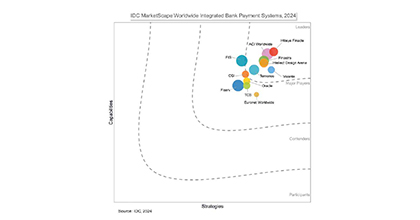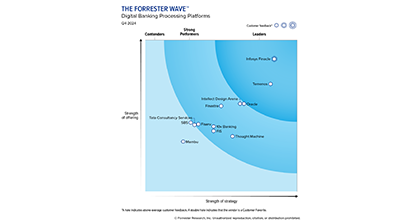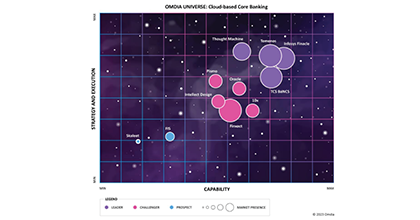-
![]() Quantum Computing: As the Future Awaits, The Strides Are DefinitiveQuantum computing is no longer confined to theory or the edges of experimental science - it is rapidly advancing toward practical impact.Read More
Quantum Computing: As the Future Awaits, The Strides Are DefinitiveQuantum computing is no longer confined to theory or the edges of experimental science - it is rapidly advancing toward practical impact.Read More -
![IDC IDC]() IDC MarketScape: Worldwide Integrated Bank PaymentFinacle Payments is an enterprise payments services system that manages end-to-end payments across instrument types, payment schemes, transaction types, customeRead More
IDC MarketScape: Worldwide Integrated Bank PaymentFinacle Payments is an enterprise payments services system that manages end-to-end payments across instrument types, payment schemes, transaction types, customeRead More -
![]() Supply Chain FinanceToday, as businesses seek to make their ecosystems more resilient, Supply Chain Finance (SCF) has emerged as a powerful lever for banks and financial institutions to support clients, while unlocking new revenue streams.Read More
Supply Chain FinanceToday, as businesses seek to make their ecosystems more resilient, Supply Chain Finance (SCF) has emerged as a powerful lever for banks and financial institutions to support clients, while unlocking new revenue streams.Read More
-
![]() The Future of Core Banking: Business and Technology EvolutionOur point of view paper, “The Future of Core Banking: Business and Technology Evolution”, serves as a candid and forward-looking benchmark of your institution’s readiness—and a strategic playbook for core modernization.Read More
The Future of Core Banking: Business and Technology EvolutionOur point of view paper, “The Future of Core Banking: Business and Technology Evolution”, serves as a candid and forward-looking benchmark of your institution’s readiness—and a strategic playbook for core modernization.Read More -
![The Forrester Wave The Forrester Wave]() Forrester Wave Digital Banking, Q4 2024Finacle is best suited for large retail, SMB, and corporate banks who seek a modern, comprehensive, innovative platform with superior support.Read More
Forrester Wave Digital Banking, Q4 2024Finacle is best suited for large retail, SMB, and corporate banks who seek a modern, comprehensive, innovative platform with superior support.Read More -
![]() Driving Comprehensive Revenue ManagementDiscover why revenue management must evolve into a comprehensive, strategic capability. Decode a blueprint to overcome challenges and unlock sustainable monetization.Read More
Driving Comprehensive Revenue ManagementDiscover why revenue management must evolve into a comprehensive, strategic capability. Decode a blueprint to overcome challenges and unlock sustainable monetization.Read More
-
![]() Shaping Banking’s Next: Banking Technology Trends for 2025 and BeyondThe banking industry has been balancing disruption and opportunity for several years now, and the pace of change shows no signs of slowing as we move into 2025 and beyond.Read More
Shaping Banking’s Next: Banking Technology Trends for 2025 and BeyondThe banking industry has been balancing disruption and opportunity for several years now, and the pace of change shows no signs of slowing as we move into 2025 and beyond.Read More -
![]() Virtual Accounts 2.0: Surpass Conventional Cash Management and Unlock Next-Gen PossibilitiesVirtual Account Management was a groundbreaking shift in the banking landscape, revolutionising use cases like cash concentration, pooling, centralised treasury management, and in-house banking (POBO, ROBO, COBO)Read More
Virtual Accounts 2.0: Surpass Conventional Cash Management and Unlock Next-Gen PossibilitiesVirtual Account Management was a groundbreaking shift in the banking landscape, revolutionising use cases like cash concentration, pooling, centralised treasury management, and in-house banking (POBO, ROBO, COBO)Read More -
![]() Unlocking Hybrid CloudAs banks push forward with their digital transformation agenda, cloud serves as a pivotal enabler. Each bank, at varying stages of adoption, crafts its unique path, dictated by context, regulations, and risk appetite.Read More
Unlocking Hybrid CloudAs banks push forward with their digital transformation agenda, cloud serves as a pivotal enabler. Each bank, at varying stages of adoption, crafts its unique path, dictated by context, regulations, and risk appetite.Read More
-
![]() Banking on CloudThis report from Infosys Finacle delves into the need for accelerating cloud adoption, highlights the current state of the industry, and puts forth key recommenRead More
Banking on CloudThis report from Infosys Finacle delves into the need for accelerating cloud adoption, highlights the current state of the industry, and puts forth key recommenRead More -
![]() Omdia Universe | Cloud-based Core BankingIn the report, Omdia highlights the following key capabilities of leading cloud-based core banking providers:Read more
Omdia Universe | Cloud-based Core BankingIn the report, Omdia highlights the following key capabilities of leading cloud-based core banking providers:Read more
-
![]() Emirates NBDEmirates NBD consolidates its operations on a single version for scalability, agility, and standardization.Read More
Emirates NBDEmirates NBD consolidates its operations on a single version for scalability, agility, and standardization.Read More -
![]() A Global Top 5 BankDiscover how a global top 5 bank headquartered in the US accelerated payments transformation.Read More
A Global Top 5 BankDiscover how a global top 5 bank headquartered in the US accelerated payments transformation.Read More -
![]() Union Bank of IndiaUnion Bank of India launches Union Virtual Connect (UVConn) by leveraging WhatsApp to provide customers personalized banking services.Read More
Union Bank of IndiaUnion Bank of India launches Union Virtual Connect (UVConn) by leveraging WhatsApp to provide customers personalized banking services.Read More

Key Trends Shaping the Global Payments Landscape in 2025 and Beyond
Blogs
The global payments landscape is undergoing a transformative shift, with projections indicating that global payment revenues will reach $2.3 trillion by 2028, albeit with a decelerated compound annual growth rate (CAGR) of 5%, down from 9% in previous years.1 This deceleration underscores the increasing complexity of the payments ecosystem, driven by evolving regulations, intensified competition, and technological advancements.
For banking executives across the globe, this divergence underscores a pressing need to adapt to an increasingly competitive landscape. To remain relevant, banks must focus on four strategic priorities:
- Modernizing legacy systems: Investing in cloud-native and API-first architectures to enhance agility and scalability.
- Embracing new payment technologies: Leveraging AI, blockchain, and open banking to enhance efficiency and security.
- Forging strategic partnerships: Collaborating with fintechs and payment service providers to accelerate innovation.
- Enhancing customer experience: Providing seamless, real-time, and hyper-personalized payment experiences.
So, what trends will define the payments landscape in 2025 and beyond? Let’s explore the key forces shaping the future of payments and how banks can turn them into opportunities for growth.
Key Trends Shaping the Payments Landscape
1. Real-Time Payments (RTP) Expands Globally
Real-time payments are becoming the industry standard, with adoption increasing by 42% YoY globally2. The US has accelerated RTP adoption through FedNow, while India’s UPI, Brazil’s Pix, and Europe’s SEPA Instant are setting new benchmarks. By 2027, RTPs are expected to account for 27.8% of all electronic payments globally3.
2. Digital Wallets and Mobile Payments Surging
The global digital payments market is projected to reach $243.42 billion by 2028, growing at a CAGR of 15.4% from 2021 to 20284. Mobile-first economies and changing consumer preferences are driving this growth. The rise of apps like WeChat Pay, Paytm, and Apple Pay is transforming consumer interactions with financial services.
3. ISO 20022: The New Global Standard
The shift to ISO 20022 is revolutionizing cross-border and domestic payments, offering richer data, improved compliance, and enhanced operational efficiency. By 2025, Swift aims to fully transition to ISO 20022, enabling seamless, 24/7 global transactions across currencies and networks. Financial institutions that fail to adopt ISO 20022 risk falling behind in the evolving payments ecosystem.
4. Regulatory Evolution: Balancing Innovation and Compliance
Governments and regulators worldwide are tightening frameworks to ensure security and financial stability. The EU’s PSD3, India’s data localization laws, and the US Digital Dollar discussions indicate increasing regulatory scrutiny. Meanwhile, central banks are actively exploring CBDCs (Central Bank Digital Currencies) to complement the digital payments ecosystem.
5. The Rise of Embedded Finance
Embedded finance is reshaping how businesses integrate financial services into non-banking platforms. The market is expected to reach $7.2 trillion by 20305. Key sub-sectors gaining momentum include:
- Buy Now, Pay Later (BNPL): Expanding beyond retail into healthcare, education, and B2B transactions.
- Open Banking: Enabling seamless connectivity between banks, fintechs, and third-party providers.
- Embedded Lending and Insurance: Allowing businesses to offer financial products directly within their ecosystems.
6. Cross-Border Payments: Faster, Cheaper, and More Transparent
Cross-border payments remain a $250+ billion industry6 but are traditionally slow and costly. However, advancements like ISO 20022 migration, Decentralized finance (DeFi)
solutions, and new blockchain-based remittance models are reducing transaction times from days to minutes. Initiatives like Swift’s GPI, Visa B2B Connect, and regional efforts like Project Dunbar (CBDCs for cross-border payments) are paving the way for a seamless global financial network.
7. The Competitive Shift: Fintechs and ISVs Challenge Banks
The payments landscape is no longer dominated by banks alone. Fintechs, neobanks, and integrated software vendors (ISVs) are rapidly capturing market share. ISVs, in particular, are embedding payment solutions within operational platforms, such as Shopify Payments or Square, creating frictionless merchant experiences.
8. Card Networks Expanding into Cross-Border Payments
Card networks are transforming into global cross-border payment players, reshaping the competitive landscape. Mastercard's Move Commercial Payments enables real-time, account-to-account cross-border transactions, while Visa's B2B Connect streamlines secure, predictable cross-border B2B payments. Both are expanding beyond traditional card-based services, challenging established payment networks.
Composable Payments Platforms: The Key to Future-Proofing Payments
As the payments ecosystem grows increasingly complex, composable payments platforms offer a transformative approach. These modular, API-driven platforms allow financial institutions to quickly adapt to new payment methods, regulations, and market shifts.
Key Features of a Composable Payments Platform:
- Modularity: Banks can assemble and disassemble components based on business needs.
- API-Centric Design: Seamless integration with third-party systems fosters ecosystem collaboration.
- Standards-Based Interoperability: Ensures compatibility across geographies and providers.
- Service Composition: Enables continuous innovation in product offerings.
- Scalability and Security: Supports increased transaction volumes while maintaining compliance.
To Conclude
The global payments market presents immense opportunities, but success will depend on how well banks adapt, innovate, and collaborate. Those that embrace next-gen payments technologies, composable platforms, and embedded finance models will not just survive but thrive in the digital-first era.
Originally published at qorusglobal.com
References:
1. Fortune Favors the Bold: Global Payments Report 2024 | BCG
5. The ecosystem imperative | Embedded finance: customer relationships and value web dynamics


Download the Latest Report
Quantum Computing: As the Future Awaits, The Strides Are Definitive


©2025 -Edgeverve Systems Limited | All rights reserved

















